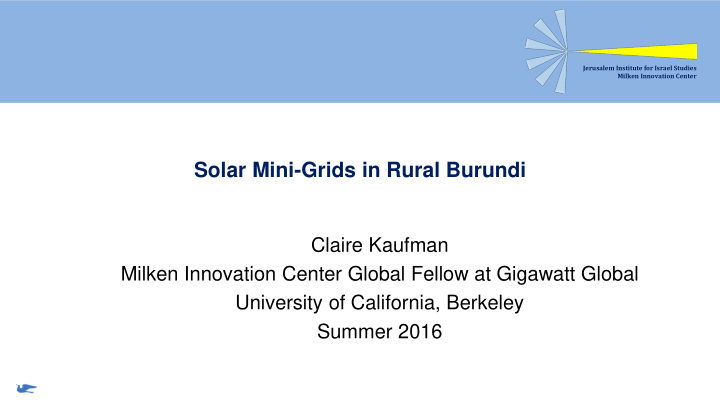



Jerusalem Institute for Israel Studies Milken Innovation Center Solar Mini-Grids in Rural Burundi Claire Kaufman Milken Innovation Center Global Fellow at Gigawatt Global University of California, Berkeley Summer 2016
Jerusalem Institute for Israel Studies Milken Innovation Center • Gigawatt Global Coöperatief U.A. is a multinational renewable energy company focused on the development and management of utility-scale solar fields in emerging markets . “A for -profit company with a non- profit’s soul” • Completed: Rwanda, Georgia, USA • In Progress: Nigeria, Kenya, West Bank, South Sudan, Benin, Burundi, Mini-grids in Burundi
Main Questions Jerusalem Institute for Israel Studies Milken Innovation Center a. How to organize, regulate, finance, and implement microgrids to create affordable, sustainable energy production and use in developing economies (Burundi). b. What are the tariff and financial structure , technology ownership and management , and system organization alternatives to enable scalability (for modular growth or connection to larger grid systems), financial feasibility (sustainability and returns to all stakeholders), and highest impacts (deliver low cost, clean energy to users).
Burundi Country Report Jerusalem Institute for Israel Studies Milken Innovation Center Economic Indicators GDP (current US $) $ 3.09 billion (2015) GDP growth -2.5% (2015) Total Population 11.18 million (2015) GDP per capita $ 276.0 (2015) (current US $) Energy Indicators Electricity Access 7% (2015) Total Average household 23 kWh/year/hh (African consumption average of 150 kWh/year) Electricity Access in 1% (2015) Rural Areas Percentage of Burundi 88% Living in Rural Areas Source: World Bank and SE4All Power Africa Energy Hub
Jerusalem Institute for Israel Studies Milken Innovation Center
The Mini-Grid Solution Jerusalem Institute for Israel Studies Milken Innovation Center
Why Are Mini-Grids Not Used More In Africa? Jerusalem Institute for Israel Studies Milken Innovation Center • “The major hurdles in the success of mini -grids are not technology-related. There are no significant technology barriers that hinder mini-grids whether they are powered by diesel generators, renewable energy or a combination of both (hybrid systems). Rather, since supply to remote villages with low income is not economically viable, financial sustainability is the key challenging factor. Compounding the problem is the fact that there is no “one -size-fits- all” solution.” (SE 4ALL Energy Access Committee, OFID 2014)
Two Part Pilot Project In Off-grid Burundi Jerusalem Institute for Israel Studies Milken Innovation Center • Street lighting mini-grid • Community mini-grid – Anchor-Based Consumer Model – Phase 2: connect school and medical clinic – Additional SHS component • Long-term goal: create a replicable model to ultimately reach 1 million Burundians
Five Key Challenges Jerusalem Institute for Israel Studies Milken Innovation Center • Matching supply & demand • Community involvement • Cheap & reliable fuel source • Managing monetary risk • Tariff formation Case studies of best practices in scalable mini-grids Two detailed feasibility study “game plans”
Demand Analysis: Community Mini-grid Jerusalem Institute for Israel Studies Milken Innovation Center
Tariff Structure Jerusalem Institute for Israel Studies Milken Innovation Center • Consumption-based tariff by kWh – vs. Capacity-based by monthly fee, Pre-Device Tariff, Energy as a service, etc. • Tiered by customer type • Time of Use
Billing Structure Jerusalem Institute for Israel Studies Milken Innovation Center • Pay-as-you-go (vs. Fixed monthly payment) – Scratch cards – Lumeter, Sparkmeter, SteamaCo
Financial Model Jerusalem Institute for Israel Studies Milken Innovation Center kWh * tariff Revenue leveraged from the grant (modeled on next slide)
Expansion Scenarios: Leverage Grant by Reinvesting Profit into 30% Equity of New, Identical Mini-Grids Every Two Years Jerusalem Institute for Israel Studies Milken Innovation Center One MG every two years: steady, upward linear As many MGs every two years as our cash flow trend. allows: exponential growth Expansion Model Expansion Model $450,000.00 16 $350,000.00 120 $400,000.00 14 $300,000.00 100 $350,000.00 12 $250,000.00 AGGREGATE CASH FLOW AGGREGATE CASH FLOW NUMBER OF MINIGRIDS NUMBER OF MINIGRIDS $300,000.00 80 10 $200,000.00 $250,000.00 $200,000.00 8 $150,000.00 60 $150,000.00 6 $100,000.00 40 $100,000.00 4 $50,000.00 $50,000.00 20 2 $- $- 1 3 5 7 9 11 13 15 17 19 21 23 25 27 29 1 3 5 7 9 11 13 15 17 19 21 23 25 27 29 $(50,000.00) 0 $(50,000.00) 0 YEAR YEAR Aggregate Cash Flows Mini-grids Aggregate Cash Flows Mini-grids
Recommend
More recommend